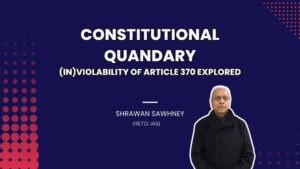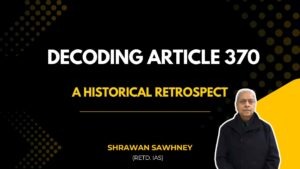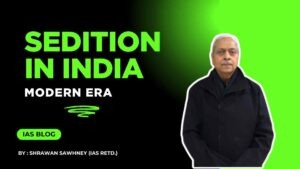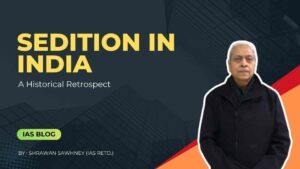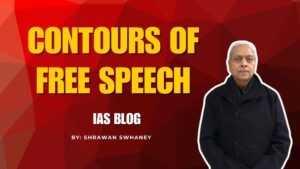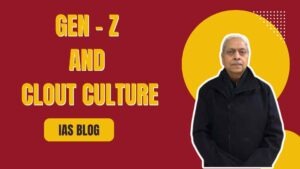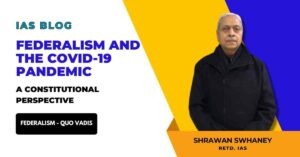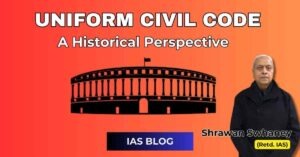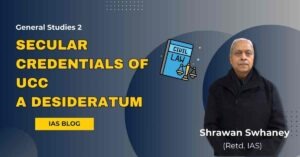Decoding Article 370 – A Historical Retrospect
Decoding Article 370 – A Historical Retrospect
The Apex Court is currently hearing petitions disputing the amendment of Article 370 of the Constitution, related with the abrogation of special status of Jammu & Kashmir. The core question is whether Article 370 could be hollowed or diluted by a notification and whether erstwhile state of Jammu & Kashmir could be stripped of its distinctive position amongst all the federating states of the Indian Union. In order to appreciate the circumstances and comprehend the issue let us traverse through its past till present times.
Despite nature’s bounty (Amir Khusro described Jammu & Kashmir as a paradise on earth),it is a travesty of this heavenly place to have witnessed invasion and usurpation of its territories by the neighbours and unfortunate status as a terror-scarred state.It would be a task far beyond the scope of the present treatise were I to attempt detailed critical account of the history of Kashmir such as it presents itself from all the extant sources, including Rig Ved, Vishnu Puran, Nilmata Puran also known as Kashmir Mahatmya, and Kalhana’s Rajatarangini (translated in English by Marc Aurel Stein). Ever since time immemorial Kashmir has always been – geographically, historically and culturally – an integral part of Bharatvarsh / India. Briefly stated, these historical accounts cover the entire span of history of Kashmir region from the earliest times detailing that the region was governed by various Hindu empires / dynasties, followed by Shah Mir and Chak Rajput dynasties. The eventual ascension of Sikh ruler, Shri Ranjit Singh and later the British involvement reshaped the fate of Jammu &Kashmir. The pivotal moment arrived in 1846 when the British sold Kashmir to Gulab Singh, Dogra Raja of Jammu. The state’s accession to the Indian Union in 1947, under Maharaja Hari Singh, a descendant of Gulab Singh, further solidified its place within the Indian Union.
It is germane to mention that, prior to accession of princely states to Indian Union, Section 5 of the Government of India Act, 1935 proclaimed India to be a federation, comprising provinces and princely states. However, none of the princely states acceded to Indian Union then, despite Section 6 of GoI Act, requiring the rulers thereof to execute Instruments of Accession. Further, the Indian Independence Act, 1947, was enacted by the British Parliament to setup Dominions of India and Pakistan. Importantly, Section 2(1) thereof provided that the territories of India shall be the territories under the sovereignty of His Majesty which were included in British India, except the territories which, were to be the territories of Pakistan.Its Section 2(4) further laid down that princely states shall be free to accede to either of the new Dominions.
Amidst this milieu, the Constituent Assembly debated Article 306A (to be Article 370later) on 17th October, 1949. Remarkably, Dr. BR Ambedkar did not participate in this debate. Under these circumstances, Shri N. Gopalaswami Ayyangar, who was a Minister without any portfolio in the first Union Cabinet and a former Diwan of Jammu & Kashmir drafted Article 306A.
Shri Ayyangar, while initiating the debate, said “Sir, this matter ……….relates to the Jammu and Kashmir State. The House is fully aware of the fact that State has acceded to the Dominion of India….. The meaning of this accession is that at present that State is a unit of a federal State namely, the Dominion of India. This Dominion is getting transformed….The Jammu and Kashmir State, therefore, has to become a unit of the new Republic of India. As the House is also aware, Instruments of Accession will be a thing of the past in the new Constitution. The States have been integrated with the Federal Republic ….. for the purpose of becoming units of the Republic and, in the case of practically all States, other than the State of Jammu and Kashmir, their constitutions also have been embodied in the Constitution for the whole of India.”
Upon being questioned by Shri Maulana Hasrat Mohani as to why this discriminatory provision is being made Shri N. Gopalaswami Ayyangar replied that “the discrimination is due to the special conditions of Kashmir. That particular State is not yet ripe for this kind of integration. It is the hope of everybody here that in due course even Jammu and Kashmir will become ripe for the same sort of integration as has taken place in the case of other States. Kashmir’s conditions are special and require special treatment. I shall briefly indicate what the special conditions are. In the first place, there has been a war going on within the limits of Jammu and Kashmir State. There was a cease-fire agreed to at the beginning of this year and that cease-fire is still on. But the conditions in the State are still unusual and abnormal. Part of the State is still in the hands of rebels and enemies…………Now, if you remember the viewpoints that I have mentioned, it is an inevitable conclusion that, at the present moment, we could establish only an interim system. Article 306A is an attempt to establish such a system.”
Shri Ayyangar further elaborated that “when the Constituent Assembly of the State has met and taken its decision on the range of federal jurisdiction over the State, the President may on the recommendation of that Constituent Assembly issue an order that this article 306A shall either cease to be operative…………….It will make a recommendation to the President who will either abrogate article 306A or direct that it shall apply with such modifications and exceptions………….”
The motion was adopted and Article 306A was added to the Constitution. Later, it became Article 370, which finds mention in Chapter XXI titled “Temporary, Transitional and Special Provisions”. Even the heading of Article 370 christens it as “temporary provisions with respect to the State of Jammu & Kashmir.”
(To be concluded)
By: Shrawan Sawhney (IAS Retd.)
The Views expressed by the author are personal.
Note: The Article was published in May 2023; therefore, it doesn’t cover the Supreme Court verdict, which was announced in December 2023.
Notes on Decoding Article 370 – A Historical Retrospect
🧭 Context
- On August 5, 2019, the Government of India abrogated Article 370, revoking the special status of Jammu & Kashmir (J&K).
- Multiple petitions challenged this move in the Supreme Court, arguing it was unconstitutional.
-
The Supreme Court heard the petitions questioning the abrogation of Article 370, which had conferred special status to Jammu & Kashmir (J&K).
-
The core issues included:
-
Whether Article 370 could be removed or diluted through a Presidential Notification.
-
Whether J&K’s distinctive constitutional status within the Indian Union could be unilaterally altered.
-
- On December 11, 2023, a 5-judge Constitution Bench delivered its judgment upholding the abrogation.
📜 Historical Background of Kashmir
-
Kashmir has long been celebrated for its natural beauty and cultural richness — Amir Khusro called it “Paradise on Earth.”
-
Historically, Kashmir has been a part of Bharatvarsh (India) since ancient times — references found in:
-
Rig Veda, Vishnu Purana, Nilamata Purana (Kashmir Mahatmya), and
-
Rajatarangini by Kalhana (12th-century historical chronicle).
-
🏰 Rulers and Political Control over Kashmir (Pre-Independence)
-
Kashmir was ruled by:
-
Ancient Hindu dynasties,
-
Later Shah Mir dynasty (first Muslim ruler),
-
Chak Rajput dynasty,
-
Then conquered by Sikh ruler Maharaja Ranjit Singh.
-
-
After Ranjit Singh’s death and British expansion:
-
Treaty of Amritsar (1846): British sold Kashmir to Gulab Singh, Dogra ruler of Jammu.
-
Thus, Dogra dynasty began its rule over Jammu & Kashmir.
-
Accession of Jammu & Kashmir to India (1947)
-
In 1947, at the time of Partition:
-
Indian Independence Act, 1947 gave princely states the option to join India or Pakistan.
-
Section 2(4): Princely states were free to accede to either dominion.
-
-
Maharaja Hari Singh, ruler of J&K (descendant of Gulab Singh), signed the Instrument of Accession with India on 26th October 1947.
-
Accession was done in light of invasion by Pakistani tribal forces (Operation Gulmarg).
-
India accepted accession conditionally, leading to special arrangements.
-
🏛️ Genesis of Article 370 (Originally Article 306A)
-
Drafted by: Shri N. Gopalaswami Ayyangar (ex-Diwan of J&K, Union Cabinet Minister without portfolio).
-
Debated on: 17 October 1949 in the Constituent Assembly.
-
Noteworthy Point: Dr. B.R. Ambedkar did not participate in the debate on Article 370.
Why Special Status for J&K?
-
War-like situation: Pakistan had attacked parts of J&K in 1947.
-
Ceasefire conditions: Some territory still under Pakistani control (now PoK).
-
Unique situation: Unlike other princely states, J&K had:
-
Not merged fully with India.
-
Its own Constituent Assembly planned to decide its relationship with India.
-
Statement by Gopalaswami Ayyangar:
-
J&K had not undergone the same integration process as other states.
-
Article 306A was to serve as a temporary arrangement till the Constituent Assembly of J&K decided on full integration.
-
Once J&K’s Constituent Assembly made its recommendations:
-
The President of India could declare Article 306A (later Article 370) to cease or be modified.
-
📘 Constitutional Status of Article 370
-
Became part of Chapter XXI of the Constitution: “Temporary, Transitional and Special Provisions.”
-
Titled: Article 370 – Temporary provisions with respect to the State of Jammu & Kashmir.
-
Main Features:
-
Limited Union jurisdiction to matters mentioned in the Instrument of Accession (Defense, Foreign Affairs, Communications).
-
Other constitutional provisions applicable only with concurrence of the J&K Government.
-
Article 370(3): Empowered the President, with the recommendation of J&K’s Constituent Assembly, to declare Article 370 inoperative.
-
🧾 What Was Article 370?
-
Gave special autonomous status to J&K.
-
Allowed:
-
A separate Constitution for J&K.
-
Limited applicability of Indian laws.
-
Special powers for the J&K Legislature.
-
-
Temporary provision in Part XXI of the Indian Constitution.
🏛️ Abrogation of Article 370 (2019)
-
Presidential Order C.O. 272:
-
Amended Article 367 to redefine the “Constituent Assembly” as the Legislative Assembly.
-
Allowed issuance of a second Presidential Order — C.O. 273 — to revoke Article 370 completely.
-
-
J&K Reorganisation Act, 2019:
-
Split the state into:
-
Union Territory of Jammu & Kashmir (with legislature)
-
Union Territory of Ladakh (without legislature)
-
-
🧩 Key Legal Issues (Discussed in Supreme Court)
-
Whether Article 370 could be abrogated after the dissolution of J&K’s Constituent Assembly in 1957.
-
Whether the President’s powers under Article 370(3) continue to exist even after J&K no longer had its own Constituent Assembly.
-
Whether J&K could be reorganized into Union Territories by Parliament (as was done in 2019).
⚖️ Supreme Court Verdict (December 11, 2023)
🧑⚖️ Bench Composition:
-
Chief Justice D.Y. Chandrachud
-
Justices S.K. Kaul, Sanjiv Khanna, B.R. Gavai, Surya Kant
🟢 Key Judgments by the Court
1. Validity of Presidential Orders
-
The Court held both orders (C.O. 272 & 273) were constitutionally valid.
-
The President retained the power under Article 370(3) even after the J&K Constituent Assembly ceased to exist in 1957.
2. On J&K’s Sovereignty
-
The majority held that J&K did not retain any sovereignty after its accession to India.
-
Cited the 1949 proclamation by Yuvraj Karan Singh, declaring Indian Constitution as supreme.
3. On Article 370’s Nature
-
Confirmed that Article 370 was a temporary provision, as originally intended.
-
The continued use of Article 370 did not convert it into a permanent feature.
4. On Federalism and Democratic Procedure
-
The President’s power under Article 370(3) did not require the recommendation of the now-defunct J&K Constituent Assembly.
-
Use of Article 356 (President’s Rule) to recommend changes was not unconstitutional.
5. On J&K’s Reorganisation
-
The reorganisation into two Union Territories was not ruled unconstitutional, but the Court directed the restoration of statehood for Jammu & Kashmir as soon as possible.
📜 Diverging Opinions Within the Bench
-
Justice Kaul’s concurring opinion:
-
Acknowledged that J&K had internal sovereignty initially.
-
Still upheld the abrogation as constitutionally valid, suggesting a truth and reconciliation commission for healing.
-
-
Justice Khanna:
-
Wrote a brief concurrence, agreeing with majority’s reasoning.
-
🔍 UPSC Relevance
📍For Prelims
-
Dates: Instrument of Accession (1947), Treaty of Amritsar (1846), Article 370 debate (1949).
-
Key people: Maharaja Hari Singh, Gopalaswami Ayyangar, Gulab Singh.
-
Articles: 370, 1 (Union of States), 3 (Formation of states), 356 (President’s Rule).
📍For Mains – GS Paper II
-
Indian Constitution – Federalism & Special Provisions.
-
Centre-State Relations, Temporary vs Permanent Provisions.
-
Role of President, Constitutional Morality, and Judicial Review.
🔖 Additional Information for Conceptual Clarity
-
Instrument of Accession: Legal document used by princely states to join India or Pakistan post-1947.
-
Government of India Act, 1935: Provided the legal base for a federal structure but was never fully implemented.
-
Indian Independence Act, 1947: Passed by British Parliament to facilitate creation of India and Pakistan.
Mains-Based Questions onDecoding Article 370 – A Historical Retrospect
❓Q1. Examine the historical and constitutional evolution of Article 370 and critically analyse its status as a “temporary provision” in the Indian Constitution.
(UPSC-style GS Paper II Question)
✅ Answer Framework:
Introduction:
Article 370 was inserted as a temporary provision in the Indian Constitution to provide special status to Jammu & Kashmir (J&K).
It originated from Article 306A, debated in the Constituent Assembly on 17 October 1949, and became Article 370 in Chapter XXI of the Constitution.
Historical Context:
J&K acceded to India in October 1947 after Pakistani tribal invasion.
The accession was conditional, and internal autonomy was retained by J&K, necessitating special constitutional arrangements.
Constitutional Evolution:
Drafted by Gopalaswami Ayyangar, Article 370 allowed:
Limited application of the Indian Constitution to J&K.
Application of other provisions only with concurrence of the J&K Government.
Article 370(3) empowered the President to abrogate it with the recommendation of J&K’s Constituent Assembly.
Temporary or Permanent? – Critical Analysis:
Though labeled as “temporary”, the J&K Constituent Assembly ceased to exist in 1957, and never recommended abrogation.
Some scholars argue it became permanent by default.
Others view “temporary” as contextual — meant for the period until integration was complete.
Judicial & Political Debates:
The 2019 abrogation of Article 370 through a Presidential Order has triggered debate over constitutional validity.
The matter is under judicial review in the Supreme Court (as of 2023–25).
Conclusion:
Article 370 represents the complexities of federalism and asymmetric integration.
Its evolution from a temporary provision to a central issue in national politics underscores the dynamic nature of the Constitution.
❓Q2. “The abrogation of Article 370 reflects a shift in Indian federalism from cooperative to coercive.” Critically discuss.
(UPSC GS Paper II – Federalism & Centre-State Relations)
✅ Answer Framework:
Introduction:
Federalism in India is described as “quasi-federal” with a strong centre.
Article 370 was an example of asymmetric federalism, granting special autonomy to J&K.
Nature of Article 370:
It restricted the Union’s legislative powers.
Required the State’s concurrence for constitutional provisions to apply.
Symbolized negotiated federalism in a diverse polity.
Abrogation of Article 370 (August 2019):
Article 370 was abrogated through a Presidential Order.
J&K was bifurcated into two Union Territories under Article 3.
The State Assembly was dissolved, and President’s Rule was in force.
Coercive Federalism – Key Arguments:
Decisions taken without elected state government.
Unilateral restructuring of a full-fledged state into UTs.
Weakening of democratic federal consultation mechanisms.
Counter View – Argument for National Integration:
Integration into Union ensures uniformity, stability, and national security.
The special status was seen by many as a barrier to development and integration.
Some argue this is constitutional federalism in action, using legitimate provisions (Articles 356, 370(3), 3).
Conclusion:
The abrogation signals a tilt toward centralisation, raising concerns over democratic federalism.
A constitutional balance is needed between unity and regional autonomy.
❓Q3. Discuss the legal and constitutional issues raised in the petitions challenging the abrogation of Article 370.
(UPSC GS Paper II – Polity and Constitution)
✅ Answer Framework:
Introduction:
The abrogation of Article 370 by Presidential Order in 2019 has been challenged in the Supreme Court.
Several constitutional issues are being examined.
Key Legal Issues:
Status of “Temporary” Provision:
Whether Article 370 was still operative after the dissolution of J&K’s Constituent Assembly (1957).
Can the President abrogate Article 370 without recommendation of the (non-existent) Assembly?
Legality of Presidential Orders:
Whether the 2019 Presidential Order modifying Article 367 to alter Article 370 was constitutionally valid.
Use of President’s Rule (Article 356):
Can the Union Government act on behalf of the J&K Government under President’s Rule to recommend its own decision?
State Reorganization:
Whether Parliament can downgrade a state into Union Territories under Article 3 without consent.
Doctrine of Constitutional Morality:
Whether the manner of abrogation violates the spirit of cooperative federalism and constitutional propriety.
Arguments in Favour of the Abrogation:
Legal route via Articles 370(1)(d), 370(3) was followed.
Parliament acting as State Assembly during President’s Rule is within legal scope.
Conclusion:
The petitions raise critical questions of federalism, constitutional powers, and democratic procedure.
The Supreme Court’s verdict will have lasting implications on Indian constitutionalism and Centre-State dynamics.
Prelims Questions based on Decoding Article 370 – A Historical Retrospect
-
Constitutional Quandary: Inviolability of Article 370 Explored
Upon adoption of the Constitution of India, the preamble proclaimed,... -
Decoding Article 370 – A Historical Retrospect
The Apex Court is currently hearing petitions disputing the amendment... -
Sedition In India-Modern Era
English inhabitants in India requested the then Indian rulers to... -
Sedition In India – A Historical Retrospect
Sedition is perhaps the very vaguest of all offences known... -
Contours of Free Speech
Recent a spate of cases against stand-up comics Munawar Faruqui,... -
Generation-Z And Clout Culture
Generation Z, also known as Gen Z-ers and Zoomers, is... -
Community Resources :An Equitable Landscape
Community Resources: An Equitable Landscape Table of Contents Blog - Community... -
Federalism and the Covid-19 Pandemic: A Constitutional Perspective
Recently, an article in a leading English national daily made... -
Uniform Civil Code – A Historical Perspective
Article 35 of the draft Constitution of India provided that... -
Secular Credentials Of UCC – Shrawan Sawhney
Recently, the 22nd Law Commission of India has set the...


